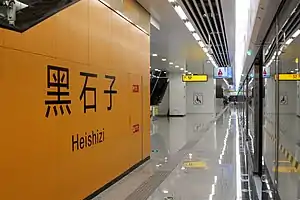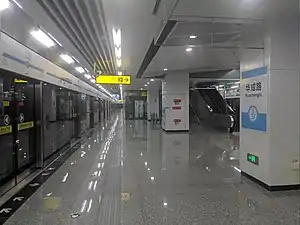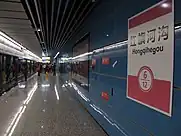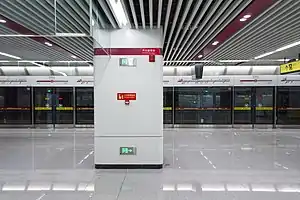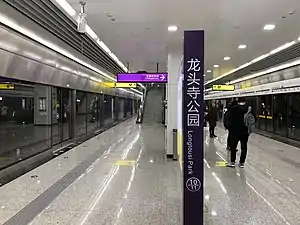Chongqing Rail Transit
The Chongqing Rail Transit (branded as CRT; also known as Chongqing Metro) is the rapid transit system in the city of Chongqing, China. In operation since 2005, it serves the transportation needs of the city's main business and entertainment downtown areas and inner suburbs. As of January 2023, CRT consisted of ten lines, with a total track length of 485.02 km (301 mi).[4] Lines 1, 4, 5, 6, 9, 10, the Loop line and Jiangtiao line are conventional heavy-rail metro lines, Lines 2 and 3 are high-capacity monorails. To keep up with urban growth, construction is under way on Line 18 and several other lines, in addition to extensions to Lines 5, 6 and 10.
| Chongqing Rail Transit | |||
|---|---|---|---|
.jpg.webp) | |||
| Overview | |||
| Native name | 重庆轨道交通 | ||
| Owner | Chongqing City Transportation Development & Investment (Group) Co., Ltd. | ||
| Area served | Chongqing Urban Area | ||
| Locale | Chongqing, China | ||
| Transit type | |||
| Number of lines | 10 | ||
| Line number | Loop 1 2 3 4 5 6 9 10 Jiangtiao | ||
| Number of stations | 279 | ||
| Daily ridership | 3.005 million (2021 avg)[1] 4.169 million (peak on 30 April 2021)[2] | ||
| Annual ridership | 1.097 billion (2021)[1] | ||
| Chief executive | Le Mei | ||
| Headquarters | 123 Renmin Rd., Yuzhong District, Chongqing | ||
| Website | http://www.cqmetro.cn | ||
| Operation | |||
| Began operation | 6 November 2004 (trial) 18 June 2005 (officially) | ||
| Operator(s) | Chongqing Rail Transit (Group) Co., Ltd. | ||
| Number of vehicles | 274[3] | ||
| Headway | 2.5 min to 12 min[3] | ||
| Technical | |||
| System length | 485.02 km (301.38 mi)[lower-alpha 1][4] | ||
| Track gauge | |||
| Electrification | |||
| Average speed | |||
| Top speed | |||
| |||
| Chongqing Rail Transit | |||||||||||
|---|---|---|---|---|---|---|---|---|---|---|---|
| Simplified Chinese | 重庆轨道交通 | ||||||||||
| Traditional Chinese | 重慶軌道交通 | ||||||||||
| |||||||||||
The Chongqing Rail Transit is a unique transit system in China because of the geography of Chongqing being a densely-populated but mountainous city, with multiple river valleys. Two lines use heavy-monorail technology, leveraging the ability to negotiate steep grades and tight curves and rapid transit capacity. They are capable of transporting 32,000 passengers per hour per direction.[5] However the busiest section of Line 3 reaches a peak passenger volume of 37,700 pphpd in 2019.[6] At 98 km (61 mi),[7] the system's two monorail lines form the longest monorail system in the world,[8] with the 56.1 km (34.9 mi) Line 3 being the world's longest single monorail line even if the 11.0 km (6.8 mi) Konggang branch is excluded.[9][10] The length and the capacity of its monorail network both also make it the world's busiest monorail system, with a total of 94 million and 250 million rides in 2015 on Line 2 and Line 3, respectively.[11] The latter ridership statistic for Line 3 also makes it the world's busiest single monorail line.
The extreme difference in elevation between the river valleys and the hilly plateaus of Chongqing pose a unique challenge in designing alignments for conventional rail transit lines. The network currently has the world's highest metro-only bridge, the Caijia Rail Transit Bridge for Line 6, spanning the Jialing River valley, with the bridge deck being approximately 100 m (328 ft) above the water.[12] Hongyancun station is the deepest metro station in China and the deepest metro station in the world with the station reaching 116 m (381 ft) below the surface,[13][14] surpassing the Kyiv Metro's Arsenalna station. Hongtudi station and Liyuchi station, both on Line 10, are the second and third deepest stations in China, being 94 m (308 ft)[15] and 76 m (249 ft)[16] below the surface respectively. Additionally, Hualongqiao station is a six story structure that has Line 10 trains stopping 48 meters above the surface,[17][18] making it the tallest metro station in the world, surpassing Smith–Ninth Streets station in New York.
The Chongqing Rail Transit system possesses a number of extremely-long metro-only bridges. The 1,650 m (5,413 ft) long Egongyan Rail Transit Bridge carries the southern arc of the Loop line across the Yangtze River using a 600 m (1,969 ft) long suspension main span, making it the longest metro-only suspension bridge by main span in the world.[19] The Nanjimen Bridge carries Line 10 trains across a 1,225 m (4,019 ft) cable-stayed bridge with a main span of 480 m (1,575 ft), making it the longest metro-only cable-stayed bridge by main span in the world.[20] The Gaojia Huayuan Jialing River Rail Transit Bridge carries the western arc of the Loop line over the Jialing River using a long 594 m (1,949 ft) bridge with a main span of 340 m (1,115 ft).[21] Additionally, Chongqing Rail Transit system has numerous double-deck bridges carrying vehicle and metro traffic, such as the Chaotianmen Bridge, which is the world's longest arch bridge.
Network

| Line | Terminus (District) |
Commencement | Newest extension | Rolling stock[lower-alpha 3] | Length (km) |
Stations | ||
|---|---|---|---|---|---|---|---|---|
| Loop | Loop line | 2018 | 2021 | 6AS | 51 | 33 | ||
| 1 | Chaotianmen (Yuzhong) | Bishan (Bishan) | 2011 | 2020 | 6B2 | 43.7 | 25 | |
| 2 | Jiaochangkou (Yuzhong) | Yudong (Ba'nan) | 2005 | 2014 | 4/6/8HL | 31.4 | 25 | |
| 3 | Yudong (Ba'nan) | Terminal 2 of Jiangbei Airport (Yubei) | 2011 | 2016 | 6/8HL | 56.1 | 45 | |
| Bijin (Yubei) | Jurenba (Yubei) | 6HL | 11.0 | |||||
| 4 | Min'an Ave. (Yubei) | Huangling (Yubei) | 2018 | 2022 | 6AS | 50.7 | 24 | |
| 5 (North) | Yuegangbeilu (Yubei) | Dashiba (Jiangbei) | 2017 | 2023 | 6AS | 25.4[22] | 16 | |
| 5 (South) | Shiqiaopu (Jiulongpo) | Tiaodeng (Dadukou) | 2021 | — | 18.3[23] | 12 | ||
| 6 | Chayuan (Nan'an) | Beibei (Beibei) | 2012 | 2020 | 6B2 | 59.8 | 40 | |
| Lijia (Yubei) | Shaheba (Yubei) | 25.8 | ||||||
| 9 | Gaotanyan (Shapingba) | Huashigou (Yubei) | 2022 | 2023 | 6AS | 40.1 | 29 | |
| 10 | Wangjiazhuang (Yubei) | Houbao (Nan'an) | 2017 | 2023 | 6AS | 38.5 | 23 | |
| Jiangtiao | Tiaodeng (Dadukou) | Shengquansi (Jiangjin) | 2022 | — | 6AS | 28.2 | 7 | |
| Total | 485.02[4] | 279 | ||||||
Loop line
The Loop line (coded as "Line 0") is a rapid transit loop line.[24] The northeastern section was opened on 28 December 2018. The southern section with the Egongyan Rail Transit Bridge opened on 30 December 2019.[25] Three major railway stations in Chongqing are also linked by this line: Chongqing North railway station, Shapingba railway station, and Chongqing West railway station. Loop Line's color is yellow.
Line 1
Line 1 runs 16.4 km (10.2 mi) from Chaotianmen, in the central west, to Shapingba and then to Bishan with a total length of 44.5 km (27.7 mi). It is the first heavy-rail subway line in Chongqing and the second in Western China. The passenger capacity is 36,000 passengers per hour in each way. The line serves as the system's backbone connecting the densest areas including the main Central Business Districts of Jiefangbei, Lianglukou, Daping, and Shapingba. It is the first conventional subway, running in a deep-bored tunnel below Yuzhong and Shapingba Districts.
Line 1 has transfer interchange stations with Line 6 at Xiaoshizi and Line 2 at Jiaochangkou in Jiefangbei CBD and at Daping and Line 3 at Lianglukou, which is near Chongqing railway station in central Yuzhong. Line 1 is also transferable with the Loop Line at Shapingba, although out-of-station transfer is currently needed due to construction setbacks on the interchange channel and concourse connecting the two subway lines.
In 1992, the Chongqing government signed a Build-Operate-Transfer agreement with a Hong Kong company and provided the land for the project, but work ceased in 1997 because of legal issues.[26] Work resumed from Chaotianmen to Shapingba on 9 June 2009, and a limited opening occurred on 28 July 2011.[27] Thales provided an operations control centre for the line. Line 1's color is red.
Line 2
Line 2, a monorail line, runs 31.4 km (19.5 mi) and has 25 stations. It begins as a subway under downtown Jiefangbei, then runs west along the southern bank of Jialing River on an elevated line, and then turns south into the southwestern inner suburbs, looping back east, to terminate at Yudong, in Ba'nan District. It runs mostly elevated, but a 2.2 km (1.4 mi) section is underground, including three of its 18 stations in the Jiefangbei CBD and central Daping areas in the extremely-dense area of Yuzhong District. Line 2 runs through four administrative districts in the central city (Yuzhong, Jiulongpo, Dadukou, and Ba'nan). In 2010, Line 2 served 45 million passengers.[28] It also runs through Daping CBD, Yangjiaping CBD in Jiulongpo District, and Chongqing Zoo at. Most trains have four cars, and six-car trains began to operate in September 2012.[29] Line 2 is the first rapid transit line to open in the Interior West of China, in 2005. In 2013, six-car trains are being implemented because of overcrowding and increasing demand.[30] Line 2's color is green.
Line 3
Line 3 is the longest and busiest monorail in the world. It runs from north to south and links the districts separated by the Yangtze (Chang Jiang) and the Jialing Rivers. The initial segment, from Lianglukou to Yuanyang (18 stations, 17.5 km (10.9 mi)), opened on 29 September 2011, with a northern extension, from Yuanyang to Jiangbei Airport, opening on 30 December 2011.[31] A southern extension, from Ertang to Yudong, opened on 28 December 2012.[32]
Most trains have six cars, more than on the older Line 2. The line started to equip eight-car trains in 2014, which are now in operation.[33] There are interchange stations in the Yuzhong district with Line 1, at Lianglukou (Caiyuanba Intercity Railway/Coach Station), and with Line 2, at Niujiaotuo. Line 3's color is indigo.
Line 4
Line 4 is a rapid transit line.[34] In June 2018, debugging of the first segment of Phase I commenced.[35] The line began operating on 28 December that year. Line 4's color is orange.
Line 5
Line 5 is a northeast–southwest heavy-rail line crossing the centre, and the line has opened its northern and southern sections of phase 1 and northern extension. It will connect Yubei, Jiangbei, Yuzhong, Jiulongpo, Shapingba and Dadukou districts. New six-car trains were introduced on the line. Line 5's color is light blue.
Line 6
Line 6 is the second heavy-rail subway line of Chongqing. Opened on 28 September 2012, it connects Nan'an, Yuzhong, Jiangbei and Yubei districts in central Chongqing.
A northern branch, from Lijia to Wulukou, Beibei District, was opened on 31 December 2013,[36] 26.2 km (16.3 mi) long with five stations. Phase 1 of the Chayuan extension was opened in 2014. Thales provided an operations control centre for the line. Line 6's color is pink.
Line 9
The first phase of Line 9 opened on 25 January 2022. Line 9's colour is crimson.
Line 10
The line serves the North Railway station and the airport terminals. The first phase (Liyuchi to Wangjiazhuang) opened on 28 December 2017, and the second phase will connect Yuzhong and Nan'an districts by crossing the Jialing and the Yangtze rivers. Two new bridges, Zengjiayan Jialing River Bridge and Nanjimen Rail Transit Bridge, are under construction for train services to the south. Line 10's color is purple.
Jiangtiao line
Jiangtiao line is a suburban rapid transit line connecting Jiangjin District with the metropolitan area. There will be through service between Line 5 and Jiangtiao line in the future. Jiangtiao line's color is blue.
Ticketing
Transport cards
CRT accepts Life & Transport Card (Chongqing Universal Card, released by Chongqing City Card Payment Co., Ltd.) and its compatible cards, released by partner companies in other cities of China. There is a 10% discount applied to the Regular Card if it is used on public transit in the city. The higher price is paid for transfers between the bus and the metro within 1 hour (not including metro-to-metro, according to the paying time). The Regular Card can be purchased at any CRT station, and a deposit can be recovered when the card is returned with its receipt. In addition the card can be used in many shops, cinemas, restaurants, etc. in Chongqing. The Students' Card and the Elders' Card can not be directly used on the metro since their monthly fee covers only buses unless a cash sub-account, which allows a 50% discount, is added to the cards for free at the service points.
Time limit
All trips must be completed in 3 hours upon entering the fare-paid area, or the highest ticket price in the system will be charged in addition.[37]
Operation
During times of heavy use like for major events, CRT may close some stations to avoid overcrowding. In 2018, CRT closed Xiaoshizi, Jiaochangkou, Qixinggang, Lianglukou, Xiaolongkan, and Shapingba stations of Line 1; Jiaochangkou and Linjiangmen stations of Line 2; Lianglukou, Huaxinjie, Guanyinqiao, and Hongqihegou stations of Line 3; Shangxinjie, Xiaoshizi, Grand Theater, Jiangbeicheng, and Hongqihegou stations of Line 6 after 20:00 on Christmas Eve, Christmas Day, after 19:00 on New Year's Eve. And they also closed Shapingba and Shangxinjie stations of Loop line after 19:00 on New Year's Eve.
From 9 to 12 November 2018, they closed Grand Theater and Jiangbeicheng stations from 10:00 to 15:00 because of heavy use during Flower Expo; from 1 to 7 November 2019, they closed Grand Theater and Jiangbeicheng stations since 10:00 till 16:00 because of heavy use during Flower Expo.
Accessibility
Almost every station has accessible elevators and toilets, and almost every train has wheelchair locks. Only the oldest rolling stock and toilets of Line 2 are not fully accessible. In addition, many older interchange channels between lines are not designed with accessibility in mind, which means the disabled there must transfer via the main concourse.[38]
Luggage rack
The trains on Line 10, which links Jiangbei Airport and Chongqing North railway station, are equipped with a luggage rack on each car.[39]
History
The CRT is part of the central government's project to develop the Western regions. The Japan Bank for International Cooperation provided some of the funding.[40] Construction was carried out, with co-operation between Changchun Railway Vehicles Co. Ltd. and Hitachi Monorail, which used advanced Japanese monorail technology.[41] Construction on Line 2 began in 1999, and the line was officially opened in June 2005 from Jiaochangkou (Jiefangbei CBD) to Zoo (Chongqing Zoo).
Early concepts and attempts
- 1946 plan: The Nationalist government made a plan of high-speed tram system. The rail weighs 47.77 kg/m, with a rail gauge of 1000 mm, a maximum slope of 9%, a minimum radius of curvature of 80 m (262 ft). The top speed is 25 km/h (16 mph) in the urban area and 45 km/h (28 mph) in the suburban area. The train was 8 m long, 1.8 m wide, with two 35-horsepower motors and a trailer. Each train took 240 passengers. The headway was designed to be 10 minutes. The system was expected to carry 1 million passengers per day. Some of the tracks were underground.
- Line A, Longmenhao – Ciqikou, 9 stations, 14.75 km (9.17 mi)
- Line B, Longmenhao – Nanwenquan, 7 stations, 19.49 km (12.11 mi)
- Line C, Longmenhao – Datiankan, 3 stations, 6.9 km (4.3 mi)
- 1958 attempt: "Yuzhong District Subway Engineering Unit" was started in late 1958, only to be suspended one year later.
- 1960 plan: A 100 km-long (62 mi) underground rapid rail transit system, linking the city center with Xinpaifang, Xiaolongkan, Yangjiaping, Shiqiaopu, Lianglukou, and other populated areas, was planned.
- 1965 attempt: The unit was reinstated. It has 4 units, including more than 1000 workers in total. Construction was stopped again in late 1966 by the Cultural Revolution. The unit was officially disbanded again in 1971. The completed tunnel sections were taken over by the civil air defense authorities.
- 1983 plan: A 12.2 km-long (7.6 mi) subway line (Chaotianmen – Yangjiaping) was planned. It is the precursor to today's Line 2.
- 1988 attempt: Some Hong Kong businessmen arrived to start a metro company in Lianglukou. The tunnel from previous attempts were extended.[26]
- 1991 plan: A 4-line 55 km-long (34 mi) monorail system was planned.
Official long-term plans
- 1998 plan: Has 5 lines in total, with a length of about 119 km (74 mi).
- 2003 and 2007 plans: Two similar expansion including 10 lines, with a total length of about 522 km (324 mi). Line 4 in the previous blueprint received a huge update and was renamed to Loop line, according to its new shape.[26]
- 2011 plan: Features 8 new lines, with a length of about 820 km (510 mi).[42]
- 2019 plan: Target a 30-line network as of 2050, with a length of about 1,473 km (915 mi).[43]
Commencement and expansions
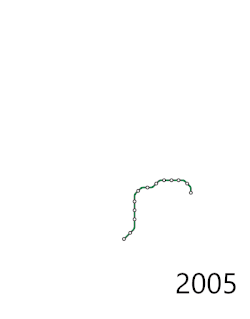
| Line | Segment | Start of construction | Began operation | |
|---|---|---|---|---|
| Phase I (2000‒2014) | ||||
| 1 | Chaotianmen | Xiaoshizi | 18 June 2007 | 31 December 2020 |
| Xiaoshizi | Jiaochangkou | 28 July 2011 | ||
| Jiaochangkou | Shapingba | 27 September 2011 | ||
| Shapingba | Daxuecheng | 20 December 2012 | ||
| Daxuecheng | Jiandingpo | 20 September 2012 | 30 December 2014 | |
| 2 | Jiaochangkou | Daping | 26 December 1999 | 11 December 2004 |
| Daping | Zoo | 6 November 2004 | ||
| Zoo | Xinshancun | 1 July 2006 | ||
| Xinshancun | Yudong | 31 July 2008 | 30 December 2014 | |
| 3 | Yudong | Chongqing Jiaotong University | 2010 | 28 December 2012 |
| Chongqing Jiaotong University | Lianglukou | 6 April 2007 | 30 December 2011 | |
| Lianglukou | Longtousi | 29 September 2011 | ||
| Longtousi | Yuanyang | December 2008 | ||
| Yuanyang | Changfulu | 8 October 2011 | ||
| Changfulu | Terminal 2 of Jiangbei Airport | 30 December 2011 | ||
| Konggang | Bijin | Jurenba | January 2013 | 28 December 2016 |
| 6 | Chayuan | Wulidian | 2009 | 30 December 2014 |
| Wulidian | Kangzhuang | 28 September 2012 | ||
| Kangzhuang | Lijia | 26 December 2012 | ||
| Lijia | Beibei | 31 December 2013 | ||
| Phase II (2012‒2020) | ||||
| Loop | Chongqing Library | Haixialu | 28 October 2013 | 28 December 2018 |
| Haixialu | Erlang | 30 December 2019 | ||
| Erlang | Chongqing Library | 20 January 2021 | ||
| 4 | Min'an Ave | Chongqing North Station North Square | 3 December 2013 | 11 January 2019 |
| Chongqing North Station North Square | Tangjiatuo | 28 December 2018 | ||
| 5 | The EXPO Garden Center | Dalongshan | 28 December 2017 | |
| Dalongshan | Dashiba | 24 December 2018 | ||
| Dashiba | Shiqiaopu | TBA | ||
| Shiqiaopu | Tiaodeng | 20 January 2021 | ||
| Int'l Expo | Lijia | Yuelai | 2009 | 15 May 2013 |
| Yuelai | Shaheba | 28 October 2016 | 31 December 2020 | |
| 9 | Xinqiao | Gaotanyan | September 2016 | TBA |
| Gaotanyan | Xingke Ave. | 25 January 2022 | ||
| Xingke Ave. | Huashigou | 2018 | 18 January 2023 | |
| 10 | Lanhualu | Houbao | 28 October 2016 | TBA |
| Houbao | Liyuchi | 28 October 2016 | 18 January 2023 | |
| Liyuchi | Wangjiazhuang | May 2014 | 28 December 2017 | |
| Phase III (2018‒2023) | ||||
| 4 | Tangjiatuo | Huangling | 25 January 2019 | 18 June 2022 |
| 5 | Yuegangbeilu | The EXPO Garden Center | 27 February 2023 | |
| 18 | Fuhualu | Tiaodengnan | TBA | |
Incidents
At around 14:00 of 8 January 2019, an improperly secured air defense lock was struck by an in service Loop line train, derailing it and causing serious damage to the cabcar.[44] The accident injured three employees and one passenger. One of the employees, the driver, later died from their injuries shortly after being sent to the hospital.[45]
Technology
| Line | Rolling stock | Signal system | Notes | |||
|---|---|---|---|---|---|---|
| Manufacturer | Trains[lower-alpha 3] | Manufacturer | CBTC | |||
| Loop | CRRC Changchun Railway Vehicles | 6As | 66 | Traffic Control Technology[lower-alpha 4] | Yes | [46] |
| 1 | CRRC Changchun Railway Vehicles | 6B | 53 | Siemens | Yes | |
| 2 | Hitachi | 4HL | 2 | The Nippon Signal | No | |
| CRRC Changchun Railway Vehicles | 4HL | 25 | ||||
| 6HL | 22 | |||||
| 8HL | 12 | Yes | ||||
| 3 | CRRC Changchun Railway Vehicles | 6HL | 54 | Hitachi | Yes | |
| 8HL | 30 | |||||
| 4 | CRRC Changchun Railway Vehicles | 6As | 49 | United Mechanical & Electrical | Yes | |
| 5 | CRRC Qingdao Sifang Locomotive & Rolling Stock | 6As | 39 | China Railway Signal & Communication | Yes | |
| CRRC Changchun Railway Vehicles | 15[lower-alpha 5] | |||||
| 6 | CRRC Changchun Railway Vehicles | 6B | 57 | Siemens | Yes | |
| Int'l Expo | CRRC Changchun Railway Vehicles | 6B | 12 | China Railway Signal & Communication | Yes | |
| 9 | CRRC Changchun Railway Vehicles | 6As | 38 | China Academy of Railway Sciences | Yes | |
| 10 | CRRC Changchun Railway Vehicles | 6As | 26 | China Academy of Railway Sciences | Yes | |
| 18 | CRRC Changchun Railway Vehicles | 6As | TBA | United Mechanical & Electrical | Yes | |
| Jiangtiao | CRRC Changchun Railway Vehicles | 6As | 15 | China Railway Signal & Communication | Yes | |
Visual design
Unlike most metro systems of other cities in China, CRT did not follow the design style of MTR Corporation in Hong Kong. The signage system was designed by GK Design Group in Japan, and the monorail lines are based on Hitachi Monorail technology. That gives the Chongqing Rail Transit a distinctive Japanese aesthetic, in contrast to other metro systems in China.[47]
CRT also gave each line a theme about the local culture, and the stations on the line will have some art works in the theme.[48]
| Line | Theme |
|---|---|
| Loop | Impressions |
| 1 | City spirit |
| 2 | Bashu culture |
| 3 | Folk life |
| 4 | Arts |
| 5 | Provisional capital era |
| 6 | Landscape |
| 10 | Citizens' memories |
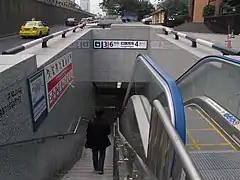 Entrance 4 of Hongqihegou Station
Entrance 4 of Hongqihegou Station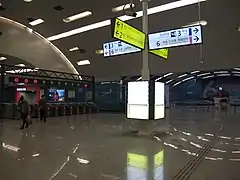 The navigation boards at the concourse of Hongqihegou Station
The navigation boards at the concourse of Hongqihegou Station The navigation board at the escalator of Daxuecheng Station
The navigation board at the escalator of Daxuecheng Station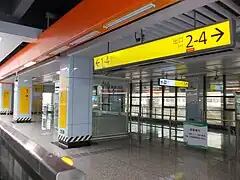 The navigation board at the platform of Tongjiayuanzi Station
The navigation board at the platform of Tongjiayuanzi Station The southern concourse of Xiaoshizi Station
The southern concourse of Xiaoshizi Station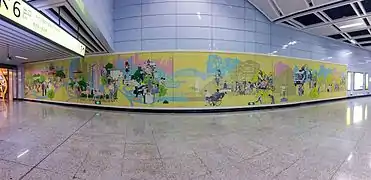 The mural on the wall of Entrance 1 of Nanping Station
The mural on the wall of Entrance 1 of Nanping Station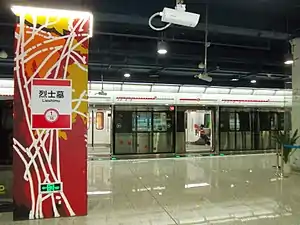 The platform of Lieshimu Station
The platform of Lieshimu Station
Expansion
CRT is expected to have 8 lines criss-crossing the urban districts by 2020 and a loop line connecting the commercial areas in the urban area. The other 9 lines are expected to be in operation by 2050.[49]

Phase 2 & 3 projects
| Planned opening | Project | Terminus | Track type | Rolling stock [lower-alpha 3] | Length (km) | New stations | Start of construction | Ref. | ||
|---|---|---|---|---|---|---|---|---|---|---|
| Late 2023 | 5 | Phase 1 - Remaining section | Shiqiaopu | Dashiba | Heavy-rail | 6As | 5.4 | 3 | 3 December 2013 | [50] |
| 10 | Phase 2 - Remaining section | Houbao | Lanhualu | Heavy-rail | 6As | 4.18 | 4 | 28 October 2016 | ||
| 18 | Phase 1 | Fuhualu | Tiaodengnan | Heavy-rail | 6As | 29.016[51] | 19 | 25 January 2019 | [51] | |
| 2025 | Bitong | Full line | Bishan | Tongliang | Heavy-rail | 6D | 37.5 | 9 | 2019 | [52][53] |
Phase 4 projects
The short-term plan, including Line 4 (West extension), Line 6 (Extension to Chongqing East Station), Lines 7, 15, 17, 24, 27 and Line 18 (Phase 2) was approved by NDRC.[54] Construction on several lines started in March 2021.[55] In April 2021, Lines 7 and 17 were redesigned from mostly elevated heavy monorails (similar to Lines 2 and 3) to conventional underground Type As metro lines akin to Lines 4, 5, 9 and 10.[56]
| Planned opening | Project | Terminus | Track type | Rolling stock[lower-alpha 3] | Length (km) | New stations | Start of Construction | Ref. | ||
|---|---|---|---|---|---|---|---|---|---|---|
| 2025 | 4 | Western extension | Min'an Ave. | Panguilu | Heavy-rail | 6As | 11.2 | 9 | 2021[55] | [57] |
| 6 | Eastern extension | Liujiaping | Chongqing East Station | Heavy-rail | 6B | 6.7 | 3 | Mar 2022[58] | [56] | |
| TBC | 7 | Phase 1 | Kexuecheng | Jinfeng | Heavy-rail | As[56] | 27.8 | 18 | Planned | [56] |
| 2025 | 15 | Phase 1 | Jiuquhe East | Liangjiang Movie City | Heavy-rail | 6D | 38.7 | 14 | 2021[55] | [55] |
| 2026 | Phase 2 | Zengjia | Jiuquhe East | Heavy-rail | 6D | 32.8 | 11 | 2021[59] | [59] | |
| TBC | 17 | Phase 1 | Shijiayuanzi | Daxuecheng | Heavy-rail | As[56] | 14.17 | 9 | Planned | [56] |
| 2025 | 18 | Northern extension | Fuhualu | Xiaoshizi | Heavy-rail | 6As | 10.6 | 8 | 2021[55] | [57] |
| 24 | Phase 1 | Lujiao North | Guangyangwan | Heavy-rail | 6As | 19 | 12 | 2021[55] | [55] | |
| 2027 | 27 | Full line | Bishan | Chongqing East Station | Heavy-rail | 6D | 49[60] | 14 | Feb 2022[60] | [60] |
| Jiangtiao | Phase 2 | Shengquansi | Dingshan | Heavy-rail | 6As | 4.524[61] | 2 | Dec 2022[61] | [61] | |
References
- "运送乘客237.1亿人次,新增运营里程1168公里…2021年城市轨道交通运营成绩单". 13 January 2022. Retrieved 19 July 2022.
- 416.9万人次!重庆轨道交通单日客运量创历史新高. Sohu (in Chinese (China)). 1 May 2021.
重庆轨道交通单日客运量首次突破400万乘次,达到416.9万人次。
- 重庆市主城区交通发展年度报告2016 (in Chinese (China)). People's Government of Chongqing. 8 April 2017.
- "Chongqing inaugurates two metro extensions". Archived from the original on 26 January 2023.
- "China's First Urban Monorail System in Chongqing" (PDF). Hitachi Ltd. 2005.
- "详情". www.camet.org.cn. Retrieved 26 June 2021.
- 重庆轨道交通3号线北延伸段开通迎客. China News (in Chinese (China)). 28 December 2016. Retrieved 28 December 2016.
- 世界最长单轨线路 (in Chinese (China)). NetEase News. 12 October 2013. Archived from the original on 8 July 2015. Retrieved 19 November 2014.
- 3号线鱼洞~二塘段基本情况. Chongqing Rail Transit (in Chinese (China)). Archived from the original on 29 November 2014. Retrieved 19 November 2014.
- "Sina Visitor System" 一不小心创造了又一个第一?. Sina Weibo (in Chinese (China)). Chongqing Rail Transit. 30 December 2011. Retrieved 19 November 2014.
- 日本单轨协会副会长石川正和一行来渝考察重庆单轨发展情况. Chongqing Rail Transit (in Chinese (China)). 18 November 2016. Archived from the original on 2 December 2016. Retrieved 2 December 2016.
- "CAIJIA RAIL TRANSIT BRIDGE". T.Y. Lin International Group. Retrieved 1 December 2016.
- "全国最深地铁站红岩村站主体开挖初支完成". 3 February 2022. Archived from the original on 3 February 2022. Retrieved 14 March 2023.
- "重庆轨道9号线红岩村站将成为全国最深地铁站_央广网". cq.cnr.cn. Retrieved 14 March 2023.
- 重庆10号线红土地站刷新"全国最深地铁站"深度. Sina News. 29 December 2017. Retrieved 30 December 2017.
- Liu Chunyuan (刘春暖). 埋深达94米相当于31层楼高 "全国最深地铁站"下还有更深地铁站_社会新闻_大众网. Danzhong Web (in Chinese (China)). Retrieved 27 January 2018.
- "关于轨道交通9号线一期,你想知道的,都在这儿啦!_重庆市人民政府网". www.cq.gov.cn. Retrieved 15 March 2023.
- "重庆9号线一期开通 化龙桥站再现"轨道穿楼"-中国科技网". www.stdaily.com. Retrieved 15 March 2023.
- 鵝公岩軌道橋高空"穿針引線" 創一世界之最. Xinhua (in Chinese (Hong Kong)). Archived from the original on 10 February 2018. Retrieved 10 February 2018.
- 南纪门长江轨道专用桥 - 公司概况 - 中铁大桥局集团第八工程有限公司 - 中国中铁成员企业. The 8th Engineering Co., Ltd., MBEC (in Chinese (China)). Retrieved 30 December 2017.
- "高家花园轨道专用桥轨道铺设完工--重庆频道--人民网". cq.people.com.cn. Retrieved 30 November 2019.
- "轨道5号线大石坝站投用". 24 December 2018.
- "重庆轨道交通一号线朝天门至小什字段、五号线一期南段(跳磴至石桥铺段)、六号线支线二期(悦来至沙河坝段)、环线重庆图书馆至重庆西站至二郎段工程初期运营前安全评估服务招标公告". 21 August 2020. Archived from the original on 30 August 2020.
- "轨道交通4号线、5号线、10号线和环线 明年部分线路有望建成通车". 17 May 2016.
- "Opening of Loop Line Southwestern Section".
- Jiang, Yong (2007). 直辖十年重庆城市交通规划与实践 (in Chinese (China)). Chongqing University Press. p. 152. ISBN 9787562441281.
- "Chongqing's metro Line 1 now open". China Cities. Archived from the original on 27 August 2011. Retrieved 31 May 2021.
- "Three more rail transit lines to put in use in Chongqing". Chongqing News. 17 October 2012. Archived from the original on 21 September 2013. Retrieved 6 January 2013.
- Dai Liu (9 July 2012). "Extended train for Chongqing Light Rail Line 2 to debut in Sept". Chongqing News. Archived from the original on 29 November 2014. Retrieved 19 November 2014.
- 重庆轨道交通2号线新增3列车上线运行. Chongqing Daily (in Chinese (China)). China News. 29 September 2013. Retrieved 19 November 2014.
- "Chongqing Rail Transit Line 3 opens to traffic". Xinhua. 30 December 2011. Retrieved 19 November 2014 – via People's Daily Website English Edition.
- 3号线鱼洞~二塘段基本情况. Chongqing Rail Transit (in Chinese (China)). Retrieved 19 November 2014.
- Liu, Xianke. 3号线8节编组列车外观就是这样的 (in Chinese (China)). Tencent Chongqing. Retrieved 19 November 2014.
- "轨道交通4号线、5号线、10号线和环线 明年部分线路有望建成通车". 17 May 2016.
- "轨道4号线不载客试运行,有望年内投用". 21 June 2018.
- Liu, Kan (1 January 2014). "Rail transit Line 6 to Beibei". Chongqing News. Retrieved 19 November 2014.
- 重庆市轨道交通票务规则. Chongqing Rail Transit (in Chinese (China)). Retrieved 9 August 2016.
- 无障碍服务. Chongqing Rail Transit (in Chinese (China)). 28 September 2012. Archived from the original on 8 April 2017. Retrieved 7 April 2017.
- Jiang, Yan; Hu, Jie (18 December 2017). 轨道也将有"超车道"! 五号线十号线将分"快慢车"-上游新闻 汇聚向上的力量. Chongqing Morning Paper (in Chinese (China)). Retrieved 24 February 2018.
- 中国の環境汚染対策、内陸部開発等を支援〜2000年度対中国円借款1,971億9,700万円を供与〜 (in Japanese). Japan Bank for International Corporation. 2000. Archived from the original on 27 September 2007. Retrieved 27 September 2007.
- "China's First Urban Monorail System in Chongqing". Hitachi Ltd. 2005. Archived from the original on 5 November 2006. Retrieved 5 October 2006.
- "国务院关于重庆市城乡总体规划的批复". www.gov.cn (in Chinese). Archived from the original on 15 January 2021. Retrieved 14 January 2021.
- "重磅!重庆主城区拟规划6条轨道快线 至2035年形成"22线1环"的轨道线网布局". Chongqing Morning (in Chinese). 28 August 2019. Archived from the original on 19 July 2020. Retrieved 14 January 2021.
- 重庆轨道交通. 突发运营信息续报. Sina Weibo (in Chinese (China)).
- 轨道环线人防门与列车发生擦碰 致3个站暂停运 其余线路正常运行. Chongqing Daily (in Chinese (China)).
- 请问重庆的轨交线路的信号系统分别是采用哪些公司的?. Metroer (in Chinese (China)). 29 September 2011. Retrieved 7 April 2017.
- "Chongqing City Subway Total Signage System, Lines No.1 and No.3 Signage Design Plan / Chongqing Metro" (PDF). GK Report. GK Design Group (23): 24. 2012. Retrieved 7 April 2017.
- "重庆轨道交通 - 线路文化". Chongqing Rail Transit (in Chinese). Retrieved 14 January 2021.
- 重庆城市轨道交通近期建设规划(2012-2020年)获批 (in Chinese (China)). Chongqing Daily. 23 February 2013. Retrieved 9 August 2016.
- 重庆轨道交通四、五号线一期工程今日开工 (in Chinese (China)). Tencent Chongqing. 3 December 2013. Retrieved 10 September 2016.
- "视频 离通车更近一步 重庆轨道交通18号线南段接触网送电成功". 24 May 2023.
- "璧铜线开工 | 璧铜线,或可促进成渝两核之间修建更多快速通道_铜梁". www.sohu.com. Retrieved 25 January 2022.
- "璧铜线开工 | 璧铜线设站9座 新型快线车从铜梁一小时飙拢解放碑-上游新闻 汇聚向上的力量". www.cqcb.com. Retrieved 25 January 2022.
- sina_mobile (21 January 2021). "轨道交通城市道路建设好消息不断". news.sina.cn. Retrieved 17 April 2021.
- "重庆新开工4条轨道线路 看看这些站有没有经过你家". 2 March 2021.
- "重庆市城市轨道交通第四期建设规划(2020~2025年)调整环境影响报告书" (PDF). Retrieved 17 April 2021.
- 重庆市城市轨道交通第四期第一批建设规划(2019‒2024年)环境影响评价公众参与第二次公示. Committee on Housing and Urban-rural Construction in Chongqing (in Chinese). 14 October 2019.
- "轨道交通6号线东延伸段开工". 28 March 2022.
- "城轨快线15号线二期开建!从沙坪坝西部直通两江新区". 12 October 2021.
- "重庆轨道交通27号线开工".
- "江跳线过江段正式开工 几江半岛半小时直通重庆中心城区". 28 December 2022. Archived from the original on 24 January 2023.
Notes
- Excluding separate networks, such as Bishan SkyShuttle or Yangtze River Ropeway.
- Except for Jiangtiao line, whose is 120 km/h
- The number refers to the number of the carriages of each train, and the letter followed refers to the type of the carriage. AS and B2 are defined by China, while HL is short for "Hitachi Large" from Japan.
Full Load Capacity Type AS B2 HL 4 1534 1240 882 6 2322 1882 1342 7 2716 - - 8 - - 1802 - Chinese: 交控科技
- Additions for the northern extension, but currently not completely manufactured
External links
- Chongqing Rail Transit official website Archived 23 June 2016 at the Wayback Machine (in Chinese), Google translation
- Chongqing Transport Card Info (in Chinese), Google translation
- UrbanRail.net's page on the Chongqing Rail Transit
- Map
- Photographs of Chongqing Rail Transit

.jpg.webp)
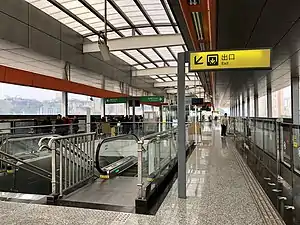
.jpg.webp)
